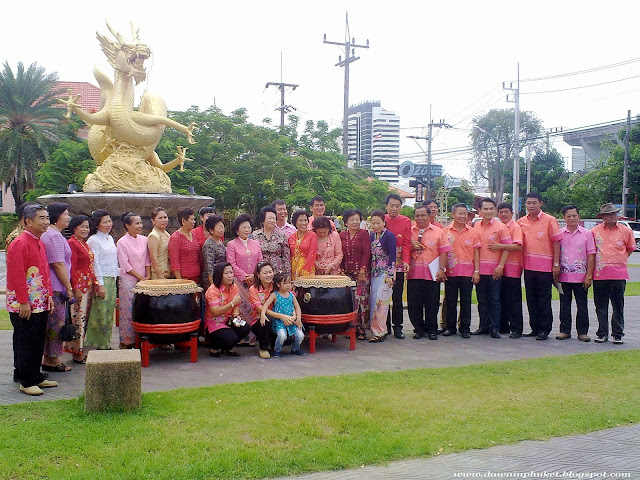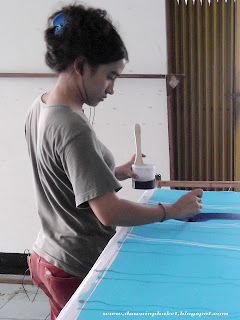Indonesian rice paddy workers c1985
I remember during my school days making 'tie and dye' fabric as well as using dripped candle wax to make similar designs. Used to love doing things like that! So when I made a trip to Bali back in the mid 1980's I fell in love with the Batik sarongs worn by the local women. The Indonesian Batik fabrics were made by using wax printing blocks called Batik Caps (tjap) that allow the wax to seep through.There was also the hand drawn method using a 'canting' (tjanting) to form the patterns but commercially this was far too time consuming and expensive. I inevitably went to a demonstration for tourists and I also ended up with several sarongs that came to be my favourite attire for hanging about at home, the habit of which is still with me even today.
Indonesian Batik on sale in Phuket
Malaysian Batik is different in style from the intricate small patterns of Indonesia and tends to be larger more floral patterns. With Thailand and Malaysia sharing the same border most of the sarongs here in Southern Thailand have a Malaysian influence and many are imported from both Malaysia and Indonesia. However a lot of batik work can be found in the very southern provinces of Thailand such as Narathiwat, where the local people have been encouraged to produce products for sale under the OTOP label.
Batik from Narathiwat.
Batik often depicts scenes from local life or the underwater world as these are popular as souvenirs.
In 1993 I decided to have a go at making batik and joined a training session at Phuket Achiwa College. It was a fun course that taught screen printing as well as batik. My end result wasn't brilliant but....
During the Phuket Old Town Festival, as well as other street festivals, the local women descending from Chinese families will dress in 'Baba - YaYa' style (บ้าบ๋า-ย่าหยา Baba-Nyonya 峇峇娘惹) that is part of the Peranakan culture.
Thai batik is made using hot wax dripped onto the base fabric using a canting. Each colour has to be done separately so the more colours the fabric has, the more expensive it will be, and really good works used for wall hangings can be may thousands of baht. I f you want to buy batik or see how it's made then try visiting Chai Batik on Chaofa East Road (Chao Fa Tawan Ork), Phuket Batik near Bangkok Hospital or Batik House near the Bangjak Petrol Station in Rawai.
Batik House Now offers Batik Classes and Homestay. (See VDO)
Viset Road
Rawai
Phuket
83130
Tel: 076 384061
Phuket Batik .
Yaowarat Road,
Sam Gong
Phuket
Tel: 076 211849
Chai Batik If you want to see the techniques this is the place to visit. (see more below)
16/3-4 Moo 3
Chaofa East Road
Muang
Phuket
83000
Tel: 076 375754
Khun Chai or Ajarn Sirichai Jansongsaeng (อาจาร สิริชัย จันทร์ส่องแสง) is a trained and skilled artist, if you visit Chai Batik you will no doubt be as impressed as I was at his works that hang on the showroom walls.
Apart from Batik you will also see drawings and paintings by Ajarn Chai, both of which have amazing detail, but you can't help wonder how such detail can be achieved when drawing in wax.
When Ajarn Chai is not away teaching in Thailand or overseas he can be seen keeping an eye on things. Batik products are produced on the premises so it is an ideal place to see how Batik is made. In the workshop next to the showroom you can see the staff working at the different stages from drawing the design in wax to painting the details and background.
Chai Batik will take special orders and have a good selection of shirts and sarongs for sale. Prices vary according to how much work is put into the design.
See also:
2013 World of Batik Exhibition at Central Festival East (Homeworks Phuket)





















No comments:
Post a Comment